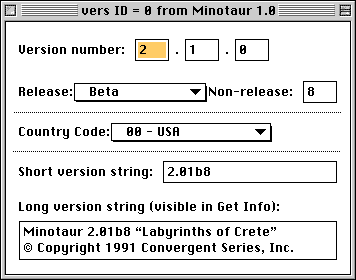
our paths conv^rge
Turn off the light... take a deep breath... and relax... this is long story. cue Qawwali voice
Back in June 22, 1998 Martin Thorne <mhornet@hotmail.com> wrote:
Upon opening a new game in PiD, the following message appears in the message window of the game:PATHWAYS INTO DARKNESS
(c) 1993 Bungie Software Products Corporation
(c) 1993 Convergent Series, Incorporated
Programming by Jason Jones...
etc.So where does Convergent Series, Incorporated come from? No mention of it is made anywhere on the box or the manual, and the disks mention something about licensors on the label but nothing very specific.
Back then I had asked whether anyone knew what Convergent Series, Inc is or was.
What I didn't include at the time was Martin's final comments which were:
Could the name Convergent Series be a subtle hint at Bungie's intentions to draw connections between PiD and Marathon? I'm just throwing out ideas here.
More recently (Mon, 03 Jan 2000) Sean Morris <legolas14@theglobe.com> wrote:
I recently got very interested in old Marathon betas when reading about them in your section on secret codes. So I got out my old Marathon CD and opened the oldest one (the macworld jan of 94 one) in ResEdit and looked through the data fork. I soon came to an interesting tidbit in the version information data. It reads: Marathon Alpha, convergent series incorporated 1993. I can't imagine why Bungie would put that in something they made.
The Convergent Series, Inc. reference in fact dates back to
Minotaur, Bungie's first Jason Jones/Alexander Seropian joint venture. An early beta version
of Minotaur contains the following information in the 'vers' resource.

The 'vers' resource in the final game however contains the following information:
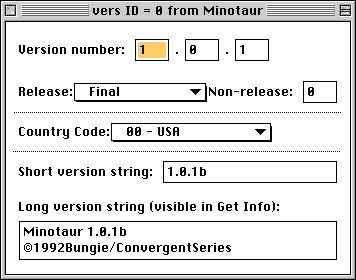
Prior to Minotaur Bungie had released two games: the freeware Gnop and the commercial
Operation: Desert Storm. In both cases the games were copyright Bungie Software
(see 'vers' resource info for Gnop and O:DS).
Of course this makes sense since Alexander Seropian wrote these under his company name "Bungie Software".
Since Minotaur was written by Jason Jones one might conclude that Convergent Series, Inc.
was Jason's company name. Jason and Alex joined forces and distributed Minotaur under the Bungie Software label and
the final release shows that the game was copyright Bungie and Convergent Series.
Pathways Into Darkness (v1.0) was similarly copyright Bungie Software and Convergent Series. Though in the final release only portions of the game were copyright Convergent Series.
It is interesting to note that the 'vers' resource for the Marathon alpha reads:

All references to Convergent Series disappeared with the release of
the Marathon demo in Nov '94.
So what? It's just a name that Jason probably came up with for a company to protect his intellectual
property rights. It's just a mathematical term for a number series in which the successive partial sums obtained by taking
more and more terms approach some fixed number or limit... right?
Well... Convergent Series is also the name of two science fiction works.
The first is by Larry Niven. The works of Larry Niven have already been cited as an influence on the Marathon story by Greg Kirkpatrick (formerly Bungie Software). Larry Niven's "Ringworld" series has also been suggested as an influence on Bungie's Halo. Niven's "Convergent Series" (published in 1979 by Ballantine Books) is in fact a series of short stories, one of which is called "Convergent Series". It is pact-with-the-devil story with a mathematical punchline. I won't spoil the story for you. If you can't find Niven's book you can find his short story "Convergent Series" in Rudy Rucker's "Mathenauts: Tales of Mathematical Wonder" published in the US by Arbor House, 1987.
The second work with the title Convergent Series is by Charles Sheffield. Although
published in 1998 by Baen Books it is in fact two books in one: Summertide (Del Rey Books, 1990) and Divergence
(Del Rey Books, 1991). Summertide and Divergence are two books in Sheffield's four part Heritage Universe series.
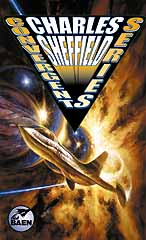
The final two books in the series (Transcendence and Convergence) have also been republished as one volume
under the title Transvergence.
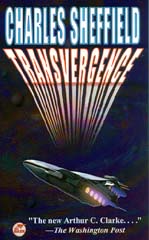
Centerpiece of Sheffield's Heritage Universe series are the "artifacts", enigmatic structures, seemingly defying natural laws,
left by an ancient vanished race. A theme similar to Larry Niven's Ringworld and one used in the Marathon series.
Here is the prolog to Sheffield's first book in the series - Summertide (1990)
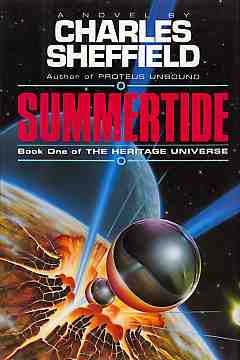
Summertide
PROLOG
Expansion
1086 (3170 A.D.)A ninety-seven-year silence was ending.
For close to a century the ship's interior had heard no human voice and felt no human footstep. The vessel whispered its way between the stars, passengers close to absolute zero in dreamless paradeath. Once a year their bodies warmed to liquid-nitrogen temperatures while shared experiences were fed to them from the ship's central data bank: memories of a hundred years of interstellar travel, for bodies that would age less than one day.
As the final weeks of deceleration began it was time to start the awakening. When the destination was reached, decisions might be needed that went beyond machine judgment—a notion that to the ship's main computer, the first of its kind to be equipped with the Karlan emotional circuits, was both insulting and implausible.
First warming was initiated. Interior sensors picked up the reassuring flutter of returning heartbeats, the initial sigh and murmur of working lungs. The emergency crew would be awakened first, two by two, on a last-in, first-out basis; only with their approval would others begin emergence.
The first pair drifted up to consciousness with one question burning in their minds: Was it arrival—or was it override?
The computer had been programmed to rouse them for only three reasons. They would be disturbed if the ship were closing at last on their destination, Lacoste-32B, a minor G-2 dwarf star that lay three light-years beyond the rose-red stellar beacon of Aldebaran. They would wake if an on-board problem had arisen within the ship's half-kilometer ellipsoid, a disaster too big for the computer to handle without human interaction.
Or, the final possibility, they would be pulled from hibernation if one of spacefaring humanity's oldest dreams had become reality:
I/T—Immediate Transfer; Interstellar Transition; Instantaneous Travel; the superluminal transportation system that would end Crawlspace exploration.
For more than a thousand years the exploration and colony ships had crept outward, widening the sphere of Earth's influence. The millennium had yielded forty colonies, scattered through a Sol-centered globe seventy light-years in diameter. But every inch within that sphere had been traveled at less than a fifth of light-speed. And every colony, no matter how small and isolated, had a research program that sought the superluminal . . .
The first two wakened were one man and one woman. They fought a century-long lassitude, queried the ship's internal status panels, and shared their relief. No on-board disaster had occured. The message center held no urgent incoming file, no news of a great breakthrough. There would be no party of superluminal travelers waiting to welcome late-arrival colonists at Lacoste.
Ahead of the ship the target star already showed a visible naked-eye disk. Gravitational perturbations of the star had long predicted the presence of at least two orbiting giant planets. Now their existence could be confirmed by direct observation, together with five smaller bodies closer to the primary.
The woman was recovering faster than the man. It was she who first left the Schindler hibernation unit, stood up shakily in the one-tenth-gee field, and moved to stare at the external displays. She uttered a low sound, a grunt of satisfaction from sluggish vocal cords, followed by an experimental clearing of her throat.
"We made it! There it is."
And there it was. The molten-gold disk of Lacoste lay at the exact center of the forward screen. Two minutes later the man had eased his way to her side, still wiping protective gel from his face. He touched her arm in congratulations, relief, and love. They were life-partners.
"Time to waken the others."
"In a few minutes," she said. "Remember Kapteyn. Make sure we've got something."
The example of Kapteyn's Star was written in every explorer's memory: eight planets, all apparently with wonderful potential; and all, on close inspection, useless for human habitation or for supplies. The early colony ship that had arrived at Kapteyn had been too depleted to reach any second target.
"We're only two light-days out," she went on. "We can start scanning. Let's take a look for oxygen atmospheres before we wake anyone else."
The on-board computer picked up her command and responded to it. One oxygen world, said its soft voice. Life probability 0.92. The field of view zoomed and swung so that Lacoste first grew rapidly in size and then disappeared from the top of the screen, while a new pinpoint of light appeared at the screen center and swelled to fill it.
Fourth planet, the computer said. Overall figure of merit for Earth isomorphism, 0.86. Mean distance, 1.22; mean temperature range, 0.89 to 1.04; axial tilt—
"What the devil is that?"
The computer paused. The man's question had no meaning.
The screen held a planet at its center, a blue-gray sphere already seen in enough detail to reveal the broad bands and swirls of atmospheric circulation patterns. But it also showed a web of hazy lines and bright spirals surrounding the planet and cradling it in multiple strands of light.
"Somebody got here ahead of us . . ." The woman's voice faded before the sentence was completed. The information network among inhabited planets was in continuous operation. It was limited to light-speed, but even so she could not believe that some exploring ship had also been sent to Lacoste, unknown to them. And if another ship had arrived here, the scale of what they were seeing went beyond anything that an exploring colony might accomplish in a few years.
Or in a few centuries.
"Pan view."
The computer heard her words and adjusted the image. The planet shrank to pea size, a bright bead of light at the middle of the screen. The surrounding nimbus of intensive in-space construction was revealed, a gleaming nacreous setting within which the planet nestled like a pearl in an oyster. Slender tendrils of construction stretched out endlessly, thinner and thinner, until they fell below the resolution of the observing sensors.
"Not our kind, Tamara," the man said softly. "That's not us."
No human works, not even the ring cities that surrounded Earth itself, came close in size and complexity. Some of the spiraling filaments around the planet had to be over four hundred thousand kilometers long and many kilometers across. They should have been unstable to gravitational forces from the planet, to tidal perturbations, and to their own interactions. And yet clearly they were not.
"Time to wake the others," Tamara said.
"And then?"
"And then . . ." She sighed. "And then, I don't know what. We finally did it, Damon. We found another intelligent species. A technologically advanced one, too. But if they could build that"—she gestured at the dazzling structure on the screen, and her voice became husky— "why didn't they find us? Well, I guess we'll know the answer to that in a few more days."
* * *
Three weeks later the ship's pinnaces were roving the veins and arteries of the space artifact. For fifteen days the main vessel had hovered five million kilometers away, waiting for and expecting contact from the planet in response to radio and laser signals. They had been met with total silence. Finally they had approached and begun direct exploration.
The misty filaments on the screen resolved themselves to the interlocking network of a colossal artifact. They stretched down to the surface of the planet, an uninhabited world apparently well suited to human colonization; but the tendrils also reached far out into space, for purposes that could not even be guessed at.
And those purposes could not be found out from their creators. Like the planet, the artifact was uninhabited.
Tamara and Damon Savalle found themselves cruising in their pinnace along one of the filaments, a metal-and-polymer tube three kilometers wide and fifty thousand long. Maintenance machines crept along the inner surface, moving so slowly that their motion was hardly perceptible. The machines ignored the little pinnace completely.
Tamara was at the communications panel, in contact with the main ship. "They confirm our analyses of meteorite pitting," she said. "At least ten million years old, uninhabited for more than three. And I don't see anything to grin at."
"Sorry." Damon did not look it. "I was thinking of the old paradox from before Expansion. If there are aliens, where are they? Twenty days ago we thought we had the answer: no aliens. Now we're asking it all over again. Where are they, Tammy? Who built all this stuff? And where are the builders?"
She shrugged. Damon's question would remain unanswered for more than three thousand years.
But while they stared and marveled, a weak incoming signal was reaching the main ship from a small and struggling colony on Eta Cassiopeiae A. It told of an intriguing new physical theory involving Bose-Einstein statistics, along with a suggestion for a subtle and complex deep-space experiment far beyond the limited resources of the little colony.
With everyone at Lacoste focused on the Builders, the new message received no attention at all.
But the Builders were long gone; and super luminal travel was on the way.
The title "Convergent Series" is taken from the theme of the first book Summertide.
I won't spoil the story for you but worth reading given that we know that the Halo back story
involves an ancient ring construct orbiting a gas giant, the creators of
which are long gone. :-)
More details about the books "Convergent Series" and "Transvergence" can be found at Baen Books. Charles Sheffield has a home page at http://www.sff.net/people/sheffield/.
So if you've read Charles Sheffield's "Convergent Series"
then what Rob Schultz <silvertail@howling.com> is about to say will be somewhat familiar. Rob writes:
At the Bungie Fan Gathering, which I attended, we were given a synopsis of Halo's story. Joe described the Halo system, which included the gas giant "Threshold". I belive this was mentioned, but when he gave the name of Threshold he stopped for a moment with a legitimate look of "oops!". Heh.. I don't think we were supposed to hear that. Anyhow, here's my theory.It struck me odd that the little Halo ring, albeit full of alien technology, could turn the tides of the Covenant war. It also seemed odd that the creators of the ring would build it out in the middle of nowhere between two, rather plain, celestial bodies (Threshold and Basis).
I thought about it for a while and came up with this: What is a "Threshold" commonly associated with? A doorway. Stew on that one for a while...
William Cromie <wjcromie@midway.uchicago.edu> writes concerning Rob Schultz's comments yesterday
about Threshold - the name of Halo's gas giant:
Just thought that the etymology might be interesting. The Romans believe that thresholds had great power. Every time they crossed a threshold they said a prayer to Janus the God of thresholds. They were considered very dangerous places because when you are on a threshold you are neither here nor there. This use of the word threshold is critical in Vergi's Aeniad.
Interesting stuff. Since Bungie have a penchant for using mythological terms in their games the naming of Halo's gas giant may be of significance. More details on the Roman god Janus can be found here.
Check out http://www.thresholds.com/ for some
Halo'ish swirls. ;-)
Mauro Braunstein <EllBrau@aol.com> writes:
Regarding the Convergent Series company, it makes me think that it is called that because Jason Jones converged his efforts to work with Alexander Seropian. He chose that book title as its name because of this. If it were because of the convergence of Marathon and PiD (they don't truly converge. They just connect), they'd keep it around for the rest of Marathon. At least the first Marathon. Jason probably decided that Bungie didn't need another one-person affiliate company when Bungie started hiring more employees. Strange thing is, I don't recall Convergent Series being ever mentioned in the Scrapbook...
Some things are best left unwritten. ;-)
Cody Miller <cody@codymiller.org> writes:
I asked Alex about this, and it was basically a company that Jason Jones had. Jason wrote code that he kept in a library to reuse, and this was his company that owned the code. So he used some of this code in Pathways which is why it's in the about box.None of Jason's code was in Gnop or Desert storm, which is why it doesn't appear there.
Early versions of Marathon had this code (it was super similar to pathways after all), but that game was basically rewritten from scratch twice - so the final game had no old code really.
Gregory Smith <wolfy@treellama.org> writes:
The CSeries library was not included with the Marathon 2 source code release, but it is a necessary part of Marathon 2. It had to be reverse engineered by the Aleph One pioneers...before my time.The Marathon Infinity source code does include the source code for CSeries (you can find it in the cseries.lib directory), so by the time the Infinity source code was released, it must have been deemed to have no proprietary value. Or it was a mistake...
Anyway, while lots of Marathon was re-written (including Jason's graphic description in the comments of the old Minotaur sound manager, and then another comment a few months later saying he can't wait to rewrite it again, which doesn't appear to have ever happened), there are parts of its core that probably haven't changed significantly since Minotaur.